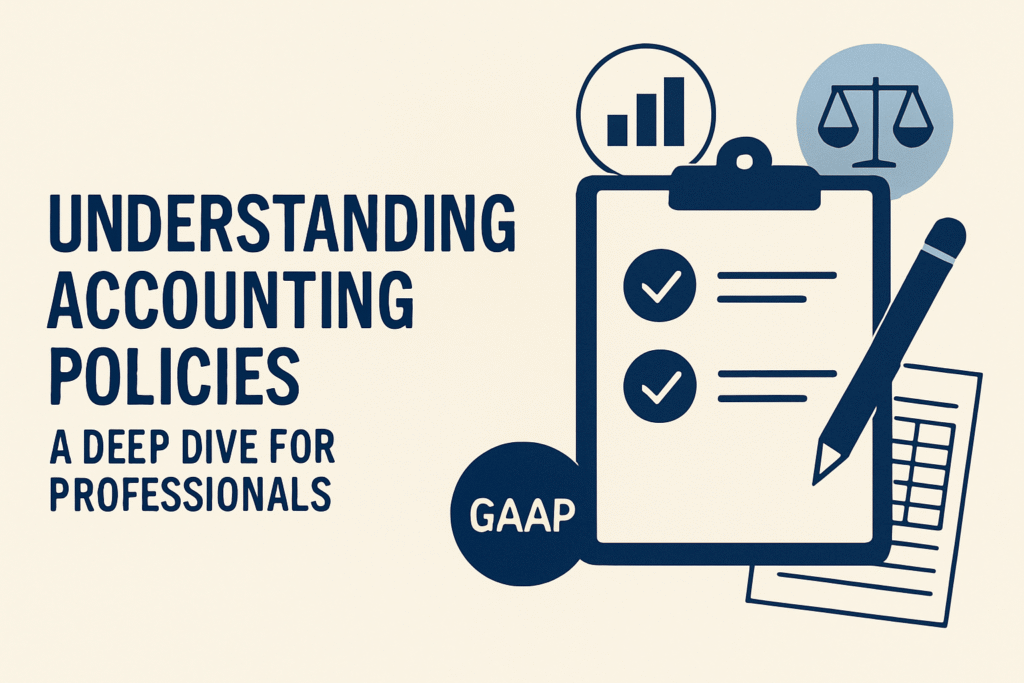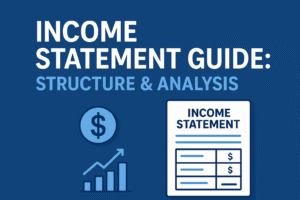In the world of financial reporting and business transparency, accounting policies serve as the blueprint guiding how organizations record, classify, and report their financial data. These policies are not arbitrary; they are carefully chosen, consistently applied, and disclosed to ensure comparability, reliability, and compliance with the relevant accounting standards such as GAAP (Generally Accepted Accounting Principles) or IFRS (International Financial Reporting Standards).
Let’s explore what accounting policies are, how they work, real-life examples, and how they differ from related accounting concepts and strategies.
What Are Accounting Policies?
Accounting policies refer to the specific principles, rules, methods, and procedures a company adopts to prepare its financial statements. They are the company’s internal accounting playbook and define the choices made when multiple accounting methods are acceptable under applicable standards.
These policies cover areas such as:
- Revenue recognition (e.g., recognize when earned or when cash is received)
- Inventory valuation (e.g., FIFO, LIFO, weighted average)
- Depreciation methods (e.g., straight-line vs. declining balance)
- Expense recognition (e.g., capitalize vs. expense)
- Foreign exchange treatment
- Lease classification
They are typically found in the notes section of a company’s audited financial statements under the “Summary of Significant Accounting Policies”.
Example: Two companies in the same industry—say, retail—may both be GAAP-compliant, yet one uses straight-line depreciation and the other uses double-declining balance. Both are following GAAP, but their accounting policies differ.
How Accounting Policies Are Used
Accounting policies serve both internal and external purposes:
Internal Use
- Guidance to Finance Teams: Policies ensure consistency in how financial transactions are recorded across departments and time periods.
- Standardization: They standardize the accounting treatment of similar transactions.
- Support Strategic Decisions: For example, a startup may choose aggressive depreciation to report higher earnings in the short term to attract investors.
External Use
- Transparency to Stakeholders: Investors, creditors, auditors, and regulators use the disclosed policies to interpret financial results and assess risk.
- Legal and Regulatory Compliance: Ensures that the company complies with GAAP, IFRS, or other regional requirements.
- Comparability: While exact figures may differ, understanding policies helps analysts make “apples-to-apples” comparisons across companies.
Example: A software company that recognizes revenue only after a customer contract is fully completed will show lower revenue in the short term than a competitor who recognizes revenue upfront. However, the first company’s revenue may be more conservative and reliable.
Example of an Accounting Policy
Let’s break down an actual accounting policy for revenue recognition.
Revenue Recognition Policy:
Company A provides annual software subscriptions to its clients. Rather than recognizing the full subscription revenue at the time of sale, Company A follows a policy of recognizing revenue monthly over the 12-month term.
So, if a customer pays $12,000 for a one-year subscription in January, Company A will recognize $1,000 per month as revenue.
This approach:
- Matches income with the period the service is delivered (matching principle)
- Prevents overstatement of revenue in January
- Increases the reliability of financial reporting
Alternative: Company B (a similar firm) might recognize the entire $12,000 upfront. Both could be GAAP-compliant depending on circumstances, but the accounting policy leads to very different financial results.
Other examples include:
- Depreciation policy: Straight-line vs. accelerated depreciation
- Inventory policy: Using FIFO vs. weighted average cost
- Bad debt policy: Estimating 2% of receivables vs. using aging schedules
What Is the Difference Between Accounting Policies and Accounting Principles?
Though closely related, accounting principles and accounting policies are not the same.
Accounting Principles:
- Are the fundamental concepts and rules that underlie accounting practices
- Include revenue recognition, matching, full disclosure, conservatism, and consistency
- Form the framework established by standard-setters like the FASB or IASB
Accounting Policies:
- Are the practical implementation of those principles
- Chosen by management from allowable methods under GAAP or IFRS
- Specific to each company’s operations, strategy, and judgment
Example: The principle of depreciation says that the cost of a long-term asset must be allocated over its useful life. The accounting policy defines how that is done—whether through straight-line, double-declining balance, or units of production method.
What Are Some Examples of Accounting Policies?
Here’s a detailed list of common accounting policies with real-world relevance:
1. Revenue Recognition
- Policy: Recognize revenue when control of the product or service transfers to the customer.
- Variation: Some recognize at point-of-sale, others over the term of a contract.
2. Inventory Valuation
- Policy: FIFO (first-in, first-out), LIFO (last-in, first-out), or weighted average.
- Impact: Affects cost of goods sold and gross margin.
- Note: LIFO is not allowed under IFRS.
3. Depreciation Method
- Policy: Straight-line, double-declining balance, sum-of-the-years’ digits.
- Example: A manufacturing company may choose double-declining balance to reflect the rapid wear and tear of its machinery.
4. Capitalization vs. Expense
- Policy: Expense R&D immediately or capitalize development costs when specific criteria are met.
- Example: A biotech firm may capitalize drug development costs only after FDA approval is likely.
5. Foreign Currency Translation
- Policy: Functional currency approach vs. historical rate method.
- Application: Affects multinational companies significantly.
6. Lease Classification
- Policy: Classify leases as finance or operating based on control and economic benefits.
- Impact: Affects asset and liability balances and expense recognition.
What Is the Difference Between Conservative and Aggressive Accounting?
Accounting policies can reflect management’s philosophy and risk appetite. Two distinct approaches are:
Aggressive Accounting:
- Goal: Inflate profits or defer losses
- How:
- Recognize revenue early
- Use longer useful lives for depreciation
- Understate reserves (e.g., bad debts)
- Capitalize expenses that could be written off
Example: A startup may capitalize marketing costs as assets to show higher profits, even if the future benefits are uncertain.
Conservative Accounting:
- Goal: Report lower profits or recognize losses earlier
- How:
- Recognize revenue only when fully earned
- Shorten useful lives of assets
- Increase provisions or allowances
- Write down inventories quickly
Example: A retail chain might write down inventory aggressively at the end of each season to reflect potential obsolescence, showing reduced profits today but cleaner books.
These choices affect investor perception, borrowing ability, and future earnings consistency.
Final Thoughts: Why Accounting Policies Matter
Accounting policies may seem like background noise to the untrained eye, but for accountants, investors, auditors, and financial analysts, they are the core of financial storytelling. The way a company recognizes revenue, values assets, or depreciates equipment can completely change how its profitability and financial health are interpreted.
Understanding accounting policies gives professionals a critical lens through which to:
- Evaluate earnings quality
- Compare financials across companies and industries
- Assess the aggressiveness or conservatism of a company’s financial posture
- Ensure regulatory compliance and audit readiness







